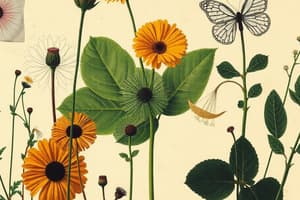Podcast
Questions and Answers
How do plants respond to stimuli?
How do plants respond to stimuli?
- By showing no response
- By releasing oxygen
- By moving towards the stimulus
- By growing towards the stimulus (correct)
Plants are heterotrophic.
Plants are heterotrophic.
False (B)
What is the process by which plants grow towards the light?
What is the process by which plants grow towards the light?
Phototropism
The exchange of gases in the leaves during respiration takes place through ______________.
The exchange of gases in the leaves during respiration takes place through ______________.
Match the following plant structures with their functions:
Match the following plant structures with their functions:
How do seedless nonvascular plants absorb and distribute water and other substances?
How do seedless nonvascular plants absorb and distribute water and other substances?
Seedless nonvascular plants have flowers.
Seedless nonvascular plants have flowers.
What is the term for the asexual form of reproduction in plants, where a single cell is surrounded by a thick cell wall for protection?
What is the term for the asexual form of reproduction in plants, where a single cell is surrounded by a thick cell wall for protection?
What is unique about the way seedless nonvascular plants move water and other substances?
What is unique about the way seedless nonvascular plants move water and other substances?
Plants are rooted in the ground and can move from one place to another.
Plants are rooted in the ground and can move from one place to another.
What is the process called by which plants grow towards the light?
What is the process called by which plants grow towards the light?
The process of producing new cells and tissues for growth in plants occurs through ______________.
The process of producing new cells and tissues for growth in plants occurs through ______________.
Match the following plant parts with their functions:
Match the following plant parts with their functions:
What is the term for the waste product of photosynthesis released by plants?
What is the term for the waste product of photosynthesis released by plants?
Plants reproduce only sexually through pollination.
Plants reproduce only sexually through pollination.
Seedless nonvascular plants absorb and distribute water and other substances directly through their _______________________ and cell walls.
Seedless nonvascular plants absorb and distribute water and other substances directly through their _______________________ and cell walls.
Flashcards are hidden until you start studying
Study Notes
Movement/Locomotion
- Plants are stationary and unable to move from one place to another due to their rooted nature.
Sensitivity
- Plants respond to stimuli like light and touch.
- Phototropism: a process by which plants grow towards light.
- Examples of phototropism:
- Stems curve to face the light.
- Roots grow towards water.
Excretion
- Plants release oxygen as a waste product of photosynthesis.
Nutrition
- Plants are autotrophic, meaning they produce their own food.
- Plants obtain mineral nutrients from the soil through their roots.
Respiration
- Leaves have tiny pores called stomata, which facilitate the exchange of gases during respiration.
- Oxygen from the air enters the leaf through stomata and reaches cells through diffusion.
Growth
- Plants grow by producing new cells and tissues.
- Growth occurs in the stem, leaves, flowers, and roots of plants.
- Mitosis: the process by which new cells are produced for growth.
Reproduction
- Plants can reproduce asexually through budding and vegetative propagation.
- Plants also reproduce sexually through pollination.
Seedless Nonvascular Plants
- Characteristics:
- Lack specialized tissues.
- Absorb and distribute water and substances through cell membranes and cell walls.
- Do not have flowers and reproduce by spores.
- Examples:
- Mosses: have green, leaflike growths arranged around a central stalk; produce spores in caps.
- Hornworts: have a flat, liver-like body; less than 2.5 in diameter; have one chloroplast per cell.
- Liverworts: have a flattened, leaflike body; rootless; have one-celled rhizoids.
Movement/Locomotion
- Plants are stationary and unable to move from one place to another due to their rooted nature.
Sensitivity
- Plants respond to stimuli like light and touch.
- Phototropism: a process by which plants grow towards light.
- Examples of phototropism:
- Stems curve to face the light.
- Roots grow towards water.
Excretion
- Plants release oxygen as a waste product of photosynthesis.
Nutrition
- Plants are autotrophic, meaning they produce their own food.
- Plants obtain mineral nutrients from the soil through their roots.
Respiration
- Leaves have tiny pores called stomata, which facilitate the exchange of gases during respiration.
- Oxygen from the air enters the leaf through stomata and reaches cells through diffusion.
Growth
- Plants grow by producing new cells and tissues.
- Growth occurs in the stem, leaves, flowers, and roots of plants.
- Mitosis: the process by which new cells are produced for growth.
Reproduction
- Plants can reproduce asexually through budding and vegetative propagation.
- Plants also reproduce sexually through pollination.
Seedless Nonvascular Plants
- Characteristics:
- Lack specialized tissues.
- Absorb and distribute water and substances through cell membranes and cell walls.
- Do not have flowers and reproduce by spores.
- Examples:
- Mosses: have green, leaflike growths arranged around a central stalk; produce spores in caps.
- Hornworts: have a flat, liver-like body; less than 2.5 in diameter; have one chloroplast per cell.
- Liverworts: have a flattened, leaflike body; rootless; have one-celled rhizoids.
Studying That Suits You
Use AI to generate personalized quizzes and flashcards to suit your learning preferences.




